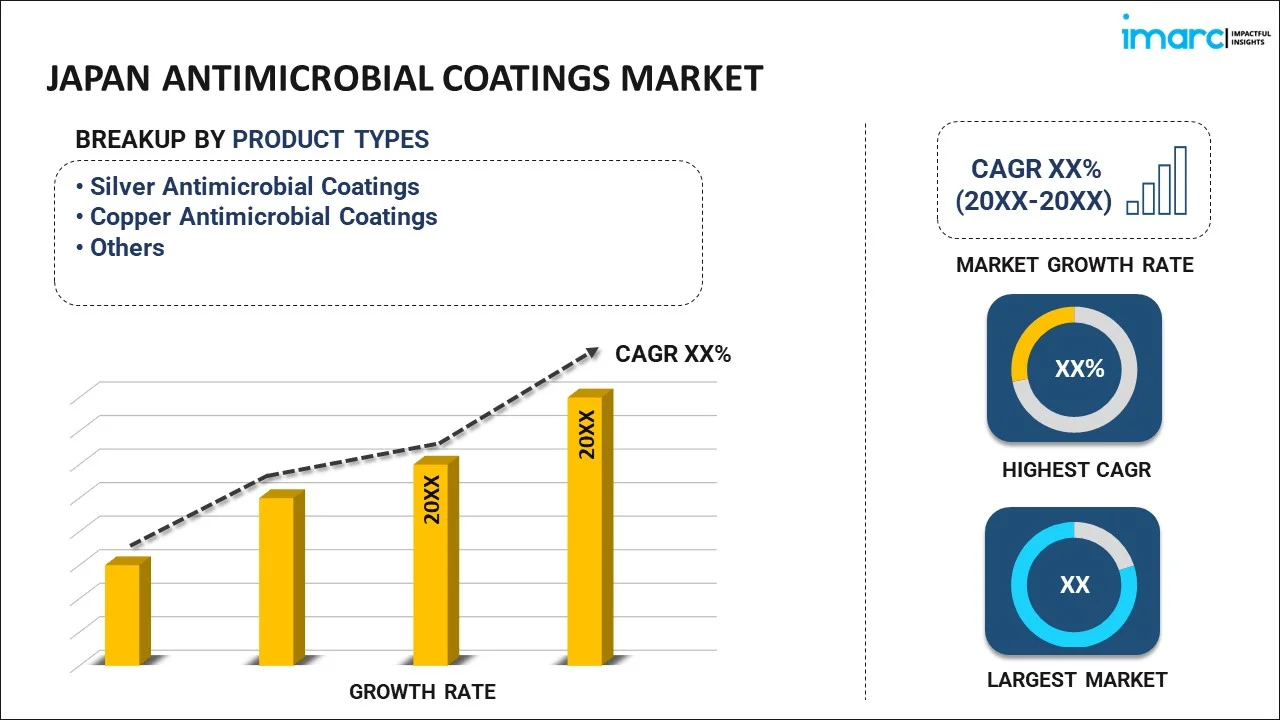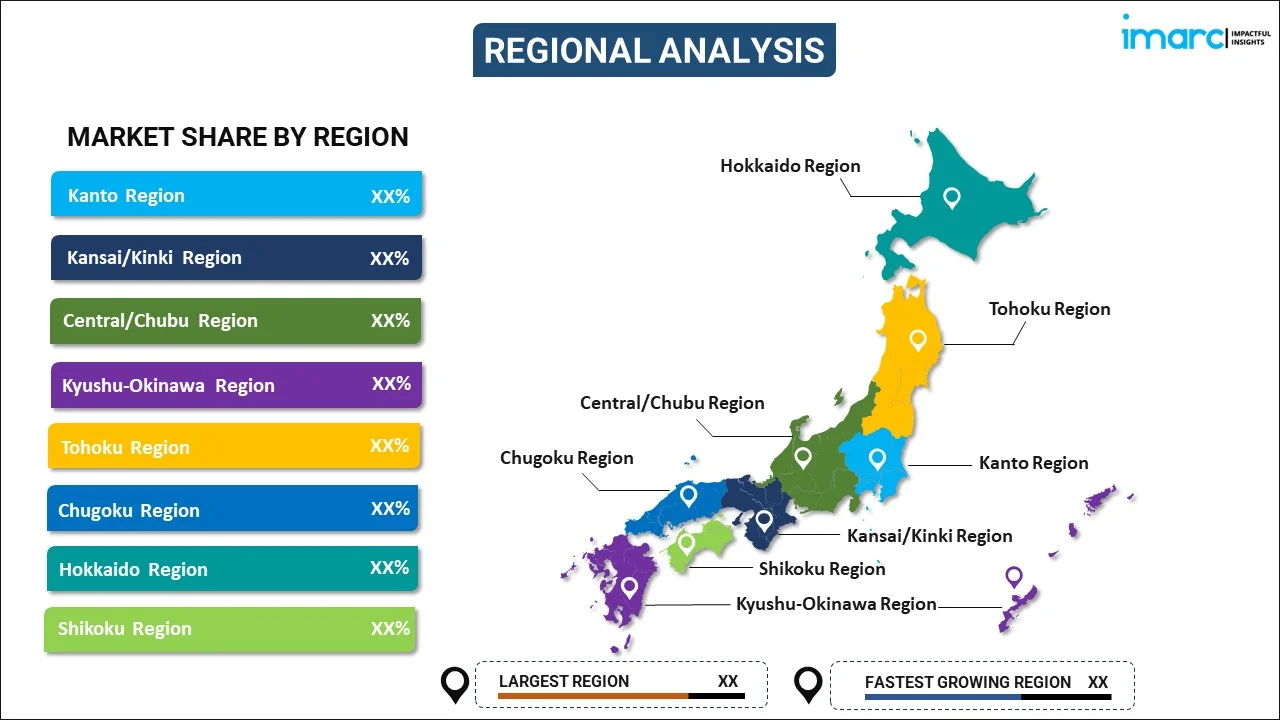
Japan Antimicrobial Coatings Market Report by Product Type (Silver Antimicrobial Coatings, Copper Antimicrobial Coatings, and Others), Application (Indoor Air Quality, Mold Remediation, Medical/Healthcare, Food and Beverage, Textile, and Others), and Region 2025-2033
Market Overview:
Japan antimicrobial coatings market size reached USD 197.1 Million in 2024. Looking forward, IMARC Group expects the market to reach USD 368.5 Million by 2033, exhibiting a growth rate (CAGR) of 6.5% during 2025-2033. The increasing cases of healthcare-associated infections, along with the rising demand for antimicrobial coatings to help in preventing the spread of illness in healthcare settings, are driving the market.
|
Report Attribute
|
Key Statistics
|
|---|---|
|
Base Year
|
2024
|
|
Forecast Years
|
2025-2033
|
|
Historical Years
|
2019-2024
|
|
Market Size in 2024
|
USD 197.1 Million |
|
Market Forecast in 2033
|
USD 368.5 Million |
| Market Growth Rate 2025-2033 | 6.5% |
Antimicrobial coatings are specialized materials designed to inhibit the growth and spread of microorganisms such as bacteria, viruses, fungi, and algae on various surfaces. These coatings are increasingly used in various industries, including healthcare, food processing, and consumer products, to promote hygiene and reduce the risk of infections. Antimicrobial coatings typically incorporate active substances like silver, copper, zinc, or quaternary ammonium compounds, which have proven antimicrobial properties. When applied to surfaces, they create a protective barrier that disrupts the growth and reproduction of microorganisms, ultimately reducing the risk of cross-contamination and the transmission of diseases. These coatings are versatile and can be used on a wide range of materials, including metals, plastics, ceramics, and textiles. They are especially valuable in healthcare settings, where they can be applied to medical devices, countertops, and even clothing to reduce the risk of hospital-acquired infections. In summary, antimicrobial coatings play a crucial role in maintaining cleanliness and safety in various industries, contributing to better public health and hygiene by preventing the proliferation of harmful microorganisms on surfaces.
Japan Antimicrobial Coatings Market Trends:
The antimicrobial coatings market in Japan is experiencing robust growth, primarily driven by a growing awareness of hygiene and infection control in various industries. Moreover, with the ongoing regional health concerns, there has been an increased demand for products that can inhibit the spread of pathogens. Consequently, this market has witnessed a surge in demand from healthcare facilities, where the need to prevent healthcare-associated infections is paramount. Furthermore, the rising use of antimicrobial coatings in consumer goods, such as textiles and electronics, has further accelerated market growth. This trend is attributed to consumers' growing preference for products that offer additional safety and cleanliness benefits. Additionally, stringent regulations and guidelines regarding infection control in healthcare and food processing industries have pushed companies to adopt antimicrobial coatings. These regulations act as a compelling force, propelling market growth as companies strive to comply and ensure the safety of their products and environments. Besides this, advancements in nanotechnology with the development of nanoscale materials, which enhance the antimicrobial properties of coatings, thereby ensuring long-lasting protection on various surfaces, are expected to drive the antimicrobial coatings market in Japan during the forecast period.
Japan Antimicrobial Coatings Market Segmentation:
IMARC Group provides an analysis of the key trends in each segment of the market, along with forecasts at the country level for 2025-2033. Our report has categorized the market based on product type and application.
Product Type Insights:

- Silver Antimicrobial Coatings
- Copper Antimicrobial Coatings
- Others
The report has provided a detailed breakup and analysis of the market based on the product type. This includes silver antimicrobial coatings, copper antimicrobial coatings, and others.
Application Insights:
- Indoor Air Quality
- Mold Remediation
- Medical/Healthcare
- Food and Beverage
- Textile
- Others
A detailed breakup and analysis of the market based on the application have also been provided in the report. This includes indoor air quality, mold remediation, medical/healthcare, food and beverage, textile, and others.
Regional Insights:

- Kanto Region
- Kansai/Kinki Region
- Central/ Chubu Region
- Kyushu-Okinawa Region
- Tohoku Region
- Chugoku Region
- Hokkaido Region
- Shikoku Region
The report has also provided a comprehensive analysis of all the major regional markets, which include Kanto Region, Kansai/Kinki Region, Central/ Chubu Region, Kyushu-Okinawa Region, Tohoku Region, Chugoku Region, Hokkaido Region, and Shikoku Region.
Competitive Landscape:
The market research report has also provided a comprehensive analysis of the competitive landscape in the market. Competitive analysis such as market structure, key player positioning, top winning strategies, competitive dashboard, and company evaluation quadrant has been covered in the report. Also, detailed profiles of all major companies have been provided.
Japan Antimicrobial Coatings Market Report Coverage:
| Report Features | Details |
|---|---|
| Base Year of the Analysis | 2024 |
| Historical Period | 2019-2024 |
| Forecast Period | 2025-2033 |
| Units | Million USD |
| Scope of the Report | Exploration of Historical Trends and Market Outlook, Industry Catalysts and Challenges, Segment-Wise Historical and Future Market Assessment:
|
| Product Types Covered | Silver Antimicrobial Coatings, Copper Antimicrobial Coatings, Others |
| Applications Covered | Indoor Air Quality, Mold Remediation, Medical/Healthcare, Food and Beverage, Textile, Others |
| Regions Covered | Kanto Region, Kansai/Kinki Region, Central/ Chubu Region, Kyushu-Okinawa Region, Tohoku Region, Chugoku Region, Hokkaido Region, Shikoku Region |
| Customization Scope | 10% Free Customization |
| Post-Sale Analyst Support | 10-12 Weeks |
| Delivery Format | PDF and Excel through Email (We can also provide the editable version of the report in PPT/Word format on special request) |
Key Questions Answered in This Report:
- How has the Japan antimicrobial coatings market performed so far and how will it perform in the coming years?
- What has been the impact of COVID-19 on the Japan antimicrobial coatings market?
- What is the breakup of the Japan antimicrobial coatings market on the basis of product type?
- What is the breakup of the Japan antimicrobial coatings market on the basis of application?
- What are the various stages in the value chain of the Japan antimicrobial coatings market?
- What are the key driving factors and challenges in the Japan antimicrobial coatings?
- What is the structure of the Japan antimicrobial coatings market and who are the key players?
- What is the degree of competition in the Japan antimicrobial coatings market?
Key Benefits for Stakeholders:
- IMARC’s industry report offers a comprehensive quantitative analysis of various market segments, historical and current market trends, market forecasts, and dynamics of the Japan antimicrobial coatings market from 2019-2033.
- The research report provides the latest information on the market drivers, challenges, and opportunities in the Japan antimicrobial coatings market.
- Porter's five forces analysis assist stakeholders in assessing the impact of new entrants, competitive rivalry, supplier power, buyer power, and the threat of substitution. It helps stakeholders to analyze the level of competition within the Japan antimicrobial coatings industry and its attractiveness.
- Competitive landscape allows stakeholders to understand their competitive environment and provides an insight into the current positions of key players in the market.
Need more help?
- Speak to our experienced analysts for insights on the current market scenarios.
- Include additional segments and countries to customize the report as per your requirement.
- Gain an unparalleled competitive advantage in your domain by understanding how to utilize the report and positively impacting your operations and revenue.
- For further assistance, please connect with our analysts.
 Inquire Before Buying
Inquire Before Buying
 Speak to an Analyst
Speak to an Analyst
 Request Brochure
Request Brochure
 Request Customization
Request Customization




.webp)




.webp)












